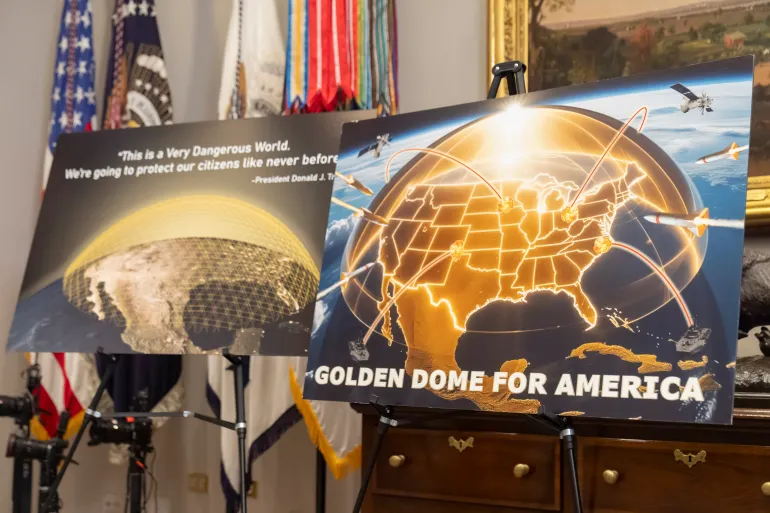Trump Unveils $175 Billion Golden Dome Missile Defense Shield, Appoints Space Force General to Lead
Washington, D.C. | May 21, 2025 — President Donald Trump officially announced the selection of a design for the ambitious $175 billion Golden Dome missile defense shield, a large-scale space-based initiative aimed at protecting the United States from growing threats posed by China and Russia. The president also appointed U.S. Space Force General Michael Guetlein as the program’s chief architect and lead.
The Golden Dome defense system, first greenlit in January, is designed to establish a vast constellation of satellites—potentially in the hundreds—to detect, track, and intercept enemy missile launches in real time. Trump emphasized the project’s scale and significance during a White House press briefing, declaring it the “keystone” of U.S. national defense policy for the future.
“Golden Dome will protect our homeland,” Trump said. “And even Canada wants in.”
Canada Signals Interest in Golden Dome Defense Collaboration
A spokesperson from Canadian Prime Minister Mark Carney’s office confirmed that discussions are ongoing with U.S. counterparts regarding deeper military and economic partnerships, including the integration of NORAD with the Golden Dome initiative.
“These discussions naturally include strengthening NORAD and related initiatives such as the Golden Dome,” the statement read.
Cost and Timeline Under Scrutiny
Trump stated the defense shield would be fully operational by January 2029, the end of his second term. However, analysts are skeptical. According to the Congressional Budget Office (CBO), total costs could soar to $831 billion over 20 years, far exceeding the initial estimate.
“The key question is over what period of time the $175 billion will be spent,” said Tom Karako of the Center for Strategic and International Studies. “It’s likely a 10-year minimum window.”
The inspiration behind Golden Dome echoes former President Ronald Reagan’s “Star Wars” program, which was shelved in the 1980s due to technological limitations.
SpaceX, Palantir, Anduril, and Defense Giants in the Spotlight
The program is expected to draw significant interest from both Silicon Valley tech firms and traditional defense contractors. Key players under consideration include:
SpaceX
Palantir Technologies (PLTR)
Anduril Industries
L3Harris Technologies (LHX)
Lockheed Martin (LMT)
RTX Corporation (RTX)
However, Democratic lawmakers have raised red flags over potential conflicts of interest—especially involving SpaceX, owned by Elon Musk, a vocal Trump supporter. Critics are demanding transparency in the procurement process and stronger oversight.
“This defense ecosystem is more about Silicon Valley than big metal,” noted Senator Kevin Cramer (R-ND), referring to the shift from legacy contractors to next-gen defense startups.
Infrastructure Boost Across Key States
President Trump highlighted that several U.S. states will benefit economically and strategically from the program. Notably:
Alaska – Strategic deployment zone
Florida – Satellite launch and logistics
Georgia – Defense tech support hubs
Indiana – Manufacturing site for L3Harris’ space sensors
L3Harris recently invested $150 million in expanding its Fort Wayne, Indiana facility to support advanced tracking systems, including Hypersonic and Ballistic Tracking Space Sensor satellites, which could be repurposed for the Golden Dome initiative.
Funding Tied to Contentious Legislation
Despite the enthusiasm, the program’s financial future is uncertain. A proposed $25 billion initial investment is embedded within a larger $150 billion defense package, which is part of a contentious reconciliation bill currently stalled in Congress.
“If reconciliation doesn’t pass, Golden Dome’s funding could fall apart,” said an anonymous defense industry executive.
Summary
Trump launches $175B Golden Dome missile shield, aims to neutralize threats from China and Russia.
General Michael Guetlein appointed to lead the program.
Satellite-based system inspired by Reagan’s Star Wars and Israel’s Iron Dome.
SpaceX, Palantir, Lockheed Martin, and others likely to play key roles.
Democrats question transparency, especially with Elon Musk’s involvement.
Funding tied to reconciliation bill facing hurdles in Congress.
States including Alaska, Florida, Georgia, and Indiana poised to benefit.
